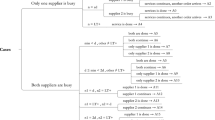Abstract
When designing, planning and controlling supply chains schedule reliability is the central objective and is a key performance indicator for assessing the logistic behaviour of a supply chain. The central influencing factor on schedule reliability is the lateness of supply chain processes. In order to comprehend possible interdependencies between logistical objectives and the influencing factor lateness various approaches have been developed for mathematically describing lateness in a supply chain’s primary processes. This paper focuses on the mathematical description of output lateness distributions in inventory systems. The developed logistic model describes the relationships between stock and service levels as well as the resulting inventory system’s output lateness distribution. Within a comprehensive simulation study the quality of the model’s depiction is demonstrated. The paper concludes with an overview of possibilities for applying the developed model for describing the lateness behaviour in supply chains.










Similar content being viewed by others
References
Handfield R, Straube F, Pfohl HC, Wieland A (2013) Trends and strategies in logistics and supply chain management: embracing global logistics complexity to drive market advantage. DVV Media Group GmbH, Bremen
Soepenberg GD, Land MJ, Gaalman GJC (2012) A framework for diagnosing the delivery reliability performance of make-to-order companies. Int J Prod Res 50:5491–5507
Szwejczewski M, Jones M (2012) Learning from world class manufacturers. Palgrave Macmillan, New York
Geissbauer R, Roussel J, Schrauf S, Strom MA (2012) Global supply chain survey 2013—next-generation supply chains: efficient, fast and tailored. PricewaterhouseCoopers AG, London
Schuh G, Stich V (2011) Produktion am Standort Deutschland [production in Germany]. FIR e.V., Aachen
Tempelmeier H (1985) Inventory control using a service constraint on the expected customer order waiting time. Eur J Oper Res 19:313–323
Akinniyi FA, Silver EA (1981) Inventory control using a service constraint on the expected duration of stockouts. AIIE Trans 13:343–348
Tempelmeier H, Fischer L (2010) Approximation of the probability distribution of the customer waiting time under an (r, s, q) inventory policy in discrete time. Int J Prod Res 48:6275–6291
Boyacı T, Gallego G (2002) Managing waiting times of backordered demands in single-stage (Q, r) inventory systems. Nav Res Logist 49:557–573
Federgruen A, Katalan Z (1996) Customer waiting time distributions under base-stock policies in single facility multi-item production systems. Nav Res Logist 43:533–548
Kruse WK (1981) Waiting time in a continuous review (s,S) inventory system with constant lead times. Oper Res 29:202–207
Tempelmeier H (2000) Inventory service-levels in the customer supply chain. OR Spektrum 22:361–380
Kiesmüller GP, de Kok AG (2006) The customer waiting time in an (R, s, Q) inventory system. Int J Prod Econ 104:354–364
Grigutsch M, Nywlt J, Bertsch S (2014) An analytical model describing the lateness distribution of storage processes. Adv Mat Res 1018:597–604
Axsäter S (2006) Inventory control. 2nd edn, Springer, New York
Gudehus T, Kotzab H (2012) Comprehensive logistics. 2nd edn. Springer, Berlin
Tersine RJ (1993) Principles of inventory and materials management. Prentice Hall, New York
Lutz S, Lödding H, Wiendahl HP (2003) Logistics-oriented inventory analysis. Int J Prod Econ 85:217–231
Lutz S (2002) Kennliniengestütztes Lagermanagement [operative curve based storage management]. VDI, Düsseldorf
Becker J (2016) Dynamisches kennliniengestütztes Bestandsmanagement [dynamic inventory management based on the logistic operating curve theory]. PZH, Garbsen
Acknowledgements
This work is funded by the German Research Foundation (DFG) under Reference Number NY 4/58-1.
Author information
Authors and Affiliations
Corresponding author
Rights and permissions
About this article
Cite this article
Nyhuis, P., Mayer, J. Logistic modelling of lateness distributions in inventory systems. Prod. Eng. Res. Devel. 11, 343–355 (2017). https://doi.org/10.1007/s11740-017-0741-8
Received:
Accepted:
Published:
Issue Date:
DOI: https://doi.org/10.1007/s11740-017-0741-8




